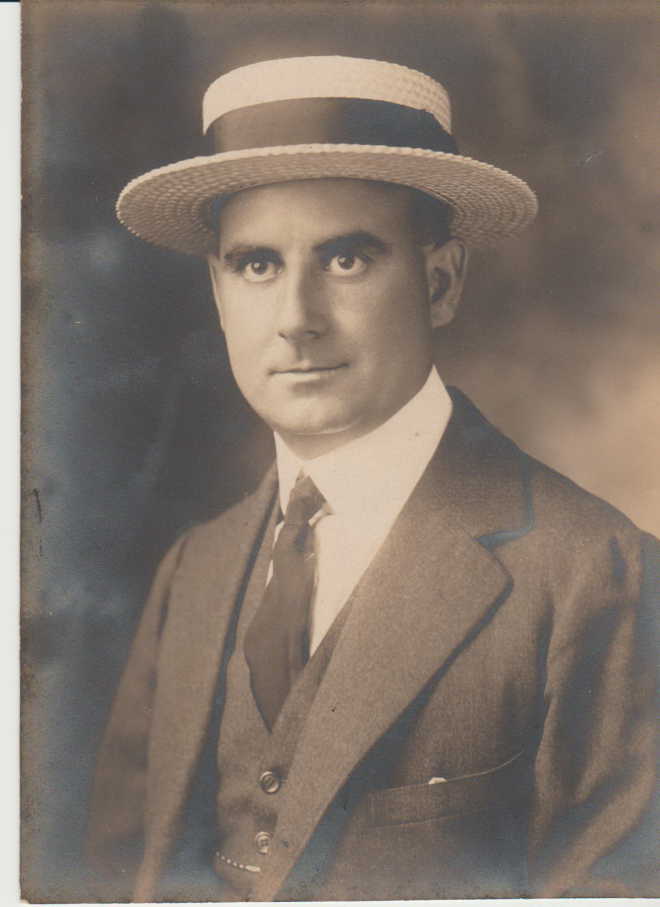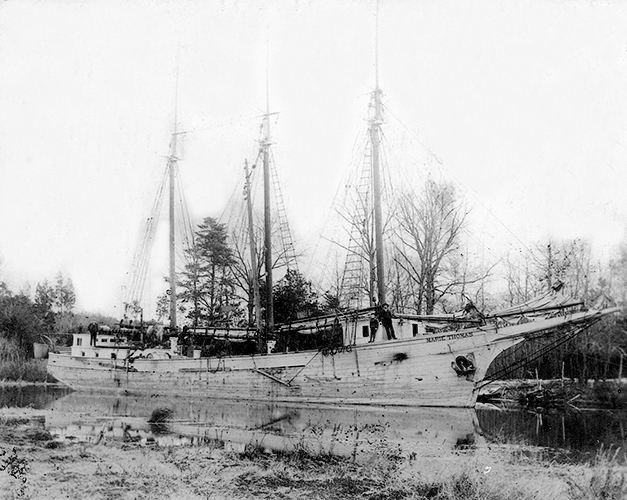In the definitive work on Milton’s shipbuilding history — Ships and Men of the Broadkill, by Capt. T. C. Conwell — 64 ships out of about 250 that were built in or docked at Milton bear women’s names. By and large, these are not names out of any mythological canon or an owner’s whimsy; no Minerva or Sea Witch or Freya or Mermaid can be found among Capt. Conwell’s exhaustive catalogue. Throughout the decades in the 19th century when ships were constructed in the Milton yards and elsewhere in the First State, they were primarily intended to be used for business, and required a lot of startup capital. It was common practice for the owner commissioning the building of a new vessel to raise money for the materials and labor by selling shares to investors, entitling them to percentages of the vessel’s future profits. Naming the vessel could be done in various ways, but often it was simply one of the investors that got to pick the name.

Such was the case with the Marie Thomas, built in 1906 by James P. Davidson in Milton and registered by owner Capt. George E. Megee on October 1 of that year. One of the twelve investors was William H. Thomas of Philadelphia, with a 25% share, the second largest stake after owner Capt. Megee’s 34%. Thomas, a lumber merchant, secured the privilege of naming the ship Marie Thomas, for his young wife Marie Lefevre Thomas. Marie gave birth to their only child, Franklin, in June of 1906, so that may have been the reason William pressed for the right to name the vessel after her.

On the paternal side, Marie Lefevre’s lineage is an interesting one. Her ancestors were Mennonites from France and Germany, first arriving in North America around 1708, disembarking in New York. Her father Franklin P. Lefevre was a Union army private in the Civil War; her great-grandfather George Lefevre Sr. served in the U. S. army during the War of 1812, and her great-great-grandfather John Lefevre served in the Continental Army during the Revolutionary War.

The Philadelphia Inquirer edition of August 29, 1906 devoted a lengthy column to the “Marine Novelty” of the Marie Thomas: a shallow draft, three-masted schooner with auxiliary power (a kerosene-fueled 60hp engine). The auxiliary power was not intended to replace wind and sail, but to augment it, making sailing more easier when winds were contrary or not present at all. The shallow draft was for the purpose of navigating Delaware’s rivers, which like the Broadkill did not run very deep and many of which were more akin to streams.
Schooners still carried cargo between Milton and Philadelphia, transporting everything from lumber and produce from the Milton end to coal, building materials, cans and manufactured goods from the Philadelphia end. But, as good as Capt. Megee’s concept sounded on paper, the reality was that the arrival of rail service in Milton (from points west) and Ellendale (from points north) was already making significant inroads into schooners’ freight business. On top of that, the kerosene-fueled engine on the Marie Thomas, less than reliable and underpowered to boot, was not up to the job.
Thus, in 1908, the Marie Thomas underwent another, drastic conversion to a steamer. The work was completed at the Milton docks in April of that year. A smokestack was added and two of her masts were removed, presumably because the owners put their faith in the reliability and power of the steam engine.
Several notices and news reports from May 1908 onward seemed to suggest that things were going well with the reconfigured vessel. In July she arrived in Milton from Philadelphia with 6000 empty cans for the Goodwin and Conwell cannery, then was chartered for four months by a company building a lighthouse twenty miles north of Cape May, NJ.
But, once again, the conversion involved a major tradeoff: the coal bunkers below deck, required to store the steam engine’s fuel, significantly reduced the space available for cargo. Once again, a concept that looked good on paper proved to be a money-loser in reality.
And, once again, another significant modification was made to the vessel: in 1909 a freight house was added above deck, considerably increasing cargo capacity. The freight house was designed for packaged (crated) freight rather than bulk such as lumber. The latter, in the form of logs or pilings, was a principal export out of the Milton area, so the Marie Thomas was out of that business for the most part.
Nine of the eleven original investors, including William H. Thomas, were still on record as owners.
Alas, this was destined to be a case of throwing good money after bad. By November of 1910, The owners of the Marie Thomas were in an untenable financial position. A deputy U. S. marshal from Philadelphia arrived in Milton and libeled the vessel, Admiralty terminology for serving a lawsuit against the owners on behalf of a plaintiff, in this case the C. H. Wheeler Manufacturing Company of Pennsylvania. The company most likely provided the boiler and other machinery for the conversion to steam power in 1908, and apparently had not been paid. A hearing was set for December 2nd in Wilmington. On that date, no one showed up in court to show cause why the steamer should not be sold, and as a consequence the judge ordered the owners to put it up for sale immediately to satisfy the claim against it.
In the late evening of December 3, 1910, the Marie Thomas caught fire at the Milton dock and burned to the waterline. Previously valued at $20,000 by one newspaper report, the vessel was a near total loss, but the crew was on shore and thus unharmed. A few days later a derrick barge arrived and lifted the wreckage out of the Broadkill, setting it on the riverbank. The burnt hull, machinery, anchors and chains, windlass, and miscellaneous remnants that survived the fire were sold by the U. S. Marshal at Wilmington, on December 19, and bought by Fred Cramer, of Philadelphia, for $190.00.
The end of the Marie Thomas was followed a decade later by the end of William and Marie Thomas’s marriage. By 1920, Marie and William appear to have separated, and divorced by 1922 when William remarried. Marie went from a comfortable life as wife of a successful businessman to working as a wrapper in a department store and living with her 80-year-old father Franklin Lefevre. She did, however, remarry a few years later and seems to have enjoyed a quiet life until her death in 1958.
Her son, Franklin Montreville Thomas, who would have been about fourteen years old in 1920, was packed off to military school, although it is unclear whether he graduated. He was, however, working in his father’s lumber business when not in school, and he would eventually take over its management. In 1954 he died in the crash of a two-seater aircraft in which he was a passenger.
Notes on sources
I am extremely indebted to Capt. T. C. Conwell’s account of the Marie Thomas story in his book Ships and Men of the Broadkill.
Other sources include:
Wilmington Evening News
Philadelphia Inquirer
Milford Chronicle
ancestry.com

Another wonderful, historically detailed report of times gone by. Thank you for keeping Milton if the past alive!
Diane, Thank you kindly for your interest in these stories. More will follow soon.
enjoyed this very much! I believe my great grandfather James Polk Davidson was one of the builders. Any other information on him? His son, Andrew J. Davidson was my grandfather from Milton,Delaware also. He went on to be the first Captain of the Lilac,a steam lighthouse tender . Would love to hear more! Sallie Davidson Macy
Yes, James P. Davidson was the builder. I don’t have much on him yet, but I could probably compile a list of the ships and other structures he built.
Do you have a photograph of him? I’d love to do a post about him and some of the other builders.
Thanks Phil!!! I shall look and see. I work full time in a hospital research lab,so it may be this weekend. Sallie Davidson Macy
I did find a picture of the house still standing in 1997 in Miltonfrom my father’s photos. Andrew A Davidson would have been his grandson. When and if I find more pictures this weekend,how do I send them to you? may I have your email? Sallie Davidson Macy Also, my maternal side of the family: Wilson were also ship builders and carpenters from Milton.
Sallie, I will send a note to your email address directly.
Enjoyed this thoroughly, Phil! Thanks for all the work you do.
Susan, thank you for your interest in these stories. More will follow.
Miss chatting with you at the museum. Any more work on the windows?
Absolutely! We have placards ready to be made for all of the windows except the compass rose ones in the attic and bell tower, and the round one in the center of the chancel. Each will have a short description of the person(s) named in the window, and four of them will have a photograph as well.
Yay!!!!
Enjoy and appreciate these stories. Thank you for being so generous with our time and work.
It adds so much to richness of this community for all. Dale Broman
Dale, your feedback is very much appreciated!
Thanks for the fascinating article!
Thanks for the fascinating article! I often wonder how the waterfront looked during the boat building era, and so appreciate you including the photos. Look forward to exploring at the Milton Historical Society once this covid cloud passes.
You and me both!